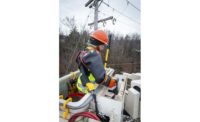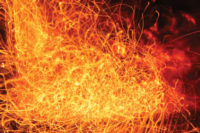Arc flashes can produce blast pressure high enough (upwards of 2,000 lbs. per square foot) to knock down humans and propel objects through air. Arc temperatures can reach 35,000° F, hot enough to melt metal and send the droplets flying. Resulting sound blast decibel level can rival that of a gunshot.1
Circumstances that can create arcs include electrical equipment malfunction and failure (spontaneous arc), dust, condensation, or corrosion. Other factors, such as a dropped or mislaid tool into an energized environment, can create an electrical bridge to enable an arc.2
It is important to note that OSHA requires live electrical parts to be de-energized before employees begin work on or near them, unless employers can demonstrate that de-energizing introduces additional or increased hazards, or is infeasible due to design or operational limitations [see 1910.333(a)(1)].
Arc flash & fall protection
Fall protection personal protective equipment (PPE) is not intended to prevent all injuries, but is intended to mitigate the impact of arc flash, should one occur. Arc-rated personal fall protection equipment following the ASTM F887 standard is designed to self-extinguish, not melt or drip and maintain integrity in the event of an arc flash fall occurrence.
A subject of potential confusion for users of arc flash fall protection equipment is conductivity, a separate safety concern from that of arc flash protection. Arc flash products are designed to resist high heat and energy. Conductivity concerns a product’s ability to conduct electricity. Common methods used to reduce conductivity of PPE include use of hardware coated with PVC, thereby insulating metal hardware away from workers. However, this practice may not eliminate all risk. ASTM F887 does not address electrical conductivity of fall protection equipment as no formal test method exists. Workers must also maintain minimum approach distances to prevent workers from contact with energized sources. As a result, exposed metal components such as D-rings and buckles used on arc flash fall arrest equipment are still common in the industry.
Regulatory & industry provisions
OSHA, as well as industry associations such as ASTM (American Society for Testing and Materials) and ANSI (American National Standards Institute), have established rules and guidelines to enable electrically safe work conditions in order to protect life, health and property. OSHA’s 29 CFR Part 1910.269 for Electric Power Generation, Transmission, and Distribution; Electrical Protective Equipment ruling created in 1986 for protection of electric power generation, transmission and distribution workers, has been revised and updated for consistency with timely corresponding general industry and construction standards and requirements. 29 CFR Part 1910.269 and Subpart V were published as of July 10, 2014. April 1, 2015, is the compliance deadline for certain fall protection, minimum approach distances and arc flash provisions.
OSHA 29 CFR Part 1910.269 changes include:3
Improved fall protection for individuals working from aerial lifts and on overhead line structures, effective July 10, 2014
- Employees working from aerial lifts must use fall restraint systems or personal fall arrest systems.
- Aerial life personal fall arrest systems must allow maximum 6-ft. free fall.
Improved fall protection for individuals at risk from arc flash exposure as well as for those who must climb structures, effective October 1, 2014
- Personal fall arrest equipment used by affected employees must also pass a drop test after electric arc exposure with heat energy of 40±5 cal/cm2.
- Fall protection equipment must be used for climbing/changing location on poles, towers or like structures unless these activities create a greater worker hazard through use of fall protection.
Revised approach-distance requirements from energized lines and equipment for unprotected workers, effective April 1, 2015
- Mechanical equipment must be insulated for voltages involved and positioned so that uninsulated portions cannot approach lines or equipment any closer than minimum approach distances specified in the standard.
New requirements to protect workers from electric arc and flame hazards, effective January 1, 2015
- Employers must conduct workplace assessment in order to identify employees who are exposed to electric arc or flame hazard through a reasonable, broad estimate of heat energy exposure.
- Employees who are exposed to these hazards must wear an employer-provided, flame-resistant outer layer clothing, Clothing must be constructed of materials that do not melt onto skin or ignite and continue to burn during exposure.
Snaphook connections, effective date April 1, 2015
- Snaphooks (non-locking) cannot be connected directly to webbing, other snaphooks, D-rings with another connected snaphook, horizontal lifeline, or any incompatibly shaped object.
Restraint Systems and Work-Positioning, effective date April 1, 2015
- If employees use fall restraint systems, employers must ensure that lanyards and anchors are rigged so that employees are not exposed to falls of any distance.
- Employees working at elevated locations of more than 4 feet (1.2 m) above ground on poles, towers or like structures, fall arrest, work positioning or travel restricting equipment must be used if other fall protection has not been provided.
Fall protection for electric utility workers
Electrical utility workers are at particular risk for arc flash injury for obvious reasons. Fall protection equipment for electric utility workers should reflect these particular needs. As discussed here, employers bear significant responsibilities; in addition to detailed workplace arc hazard assessment, with some exceptions, employers must ensure that employees exposed to arc hazards wear flame-resistant and arc-rated clothing and other arc flash PPE. Fall protection products for protection from arc flash hazards should offer features such as flame resistance properties through 100% Kevlar webbing.
Some new provisions of OSHA 29 CFR Part 1910.269 for Electric Power Generation, Transmission, and Distribution; Electrical Protective Equipment have already taken effect. Be informed of how these changes affect your fall protection safety program to enhance worker safety and to help prevent property damage.
Footnotes
1 Department of Health & Human Services, Arc Flash Awareness, NIOSH Publication No. 2007–116D
2 Department of Health & Human Services, Arc Flash Awareness, NIOSH Publication No. 2007–116D
3 www.osha.gov, 1910.269 Electric Power Generation, Transmission, and Distribution



